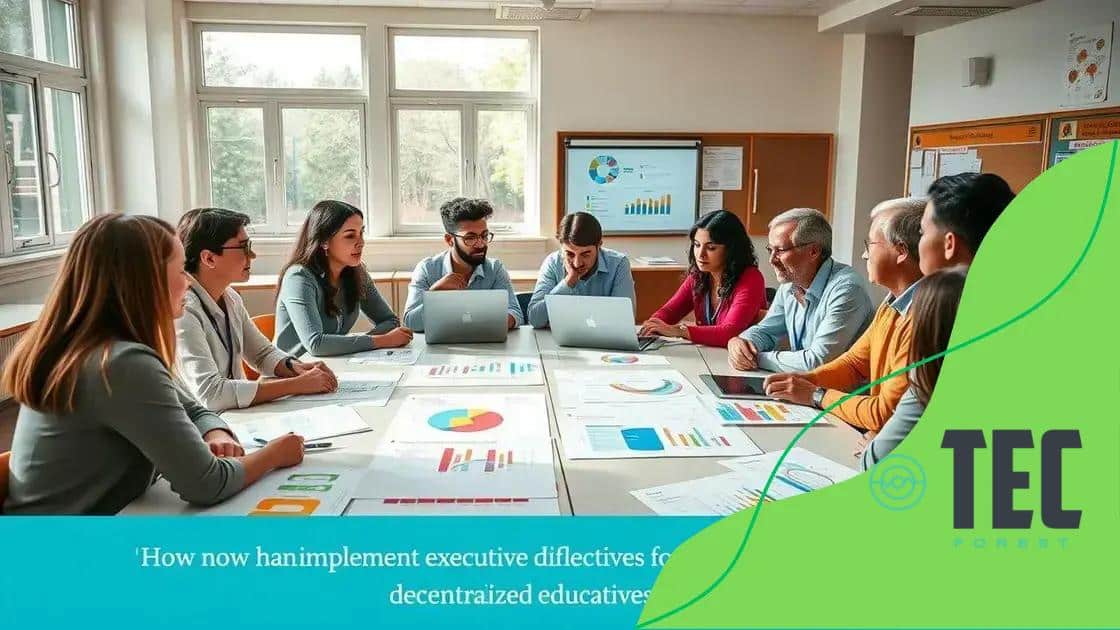Advertisement
Executive directives support decentralized education structures by empowering local communities, enhancing educational equity, and promoting innovative practices tailored to specific student needs.
Executive directives support decentralized education structures, transforming how we approach learning. Curious about how this affects students and educators? Let’s dive in!
Advertisement
Understanding executive directives in education
Understanding executive directives in education is crucial for grasping how today’s learning environments are shaped. These directions set the tone for how educational systems function, aiming to improve outcomes for students.
Executive directives are formal instructions that come from government officials or agencies. They influence policies and practices in educational institutions, ensuring they align with broader societal goals. By directing resources and focusing on specific objectives, these directives can lead to more decentralized forms of education.
Advertisement
The Role of Executive Directives
These directives play a key role in educational reform. They guide decision-making and help schools adopt innovative practices designed to meet the diverse needs of their students. With an emphasis on decentralization, the goal is to empower local schools and communities.
- They encourage local governance in schools.
- They promote equitable access to resources.
- They support tailored educational programs.
In addition, executive directives often emphasize accountability. Schools must demonstrate how they are using resources effectively and improving student outcomes. This focus ensures that decentralization doesn’t compromise quality; rather, it enhances it by being responsive to local needs.
Impact on Educational Practices
As these directives take effect, educational practices evolve. Teachers are given more autonomy in their classrooms, allowing them to adapt lessons to fit the unique contexts of their students.
Moreover, executive directives facilitate collaboration among educators. When each school has the flexibility to adopt its own approach, sharing successful strategies becomes vital. Schools can learn from one another, fostering a culture of continuous improvement.
In this dynamic landscape, it’s essential to remain aware of how these directives impact students directly. They often bring forth new resources and tools that enhance learning experiences—making education more engaging and relevant.
How directives support decentralization

Understanding how directives support decentralization is essential for grasping the evolving landscape of education. These directives pave the way for more local control and adaptability within educational systems.
When a directive emphasizes decentralization, it often aims to give more power to local educational authorities. This shift allows communities to make decisions that best fit their unique student populations. Consequently, schools can create tailored programs that address specific needs and challenges faced by their students.
Benefits of Decentralization
Decentralization brings numerous benefits that enhance educational experiences. Greater flexibility in decision-making is one major advantage. Local educators and administrators can quickly adapt their strategies based on immediate feedback and changing circumstances.
- Customized learning opportunities for students.
- Increased community engagement in schools.
- Faster implementation of innovative teaching methods.
Moreover, decentralization fosters a sense of ownership among educators and parents. When communities are actively involved, they feel more invested in the success of their schools. This sense of investment often translates into better student outcomes.
The Role of Executive Directives
Executive directives act as the framework supporting this decentralization. They establish guidelines that help to align local initiatives with broader educational goals. This alignment ensures that while schools have the autonomy to operate independently, they remain committed to achieving overall quality and equity in education.
In practice, these directives encourage sharing between schools and districts. When successful strategies are identified, they can be disseminated widely, leading to improved educational practices across various settings. This collaborative spirit enhances the effectiveness of decentralized approaches.
In summary, understanding how directives support decentralization sheds light on the importance of local control in education. As communities gain more authority, the potential for innovative solutions tailored to each student’s needs increases significantly.
The impact on educational equity
The impact of executive directives on educational equity is profound. These directives are designed to create fair access to quality education for all students, regardless of their background.
When implemented effectively, executive directives address disparities in educational resources. They ensure that underserved communities receive the support they need to thrive. By focusing on equity, these directives aim to level the playing field, giving every student a chance to succeed.
Key Factors Influencing Educational Equity
Several essential factors contribute to educational equity under the influence of directives. First, funding disparities are addressed, allowing schools in low-income areas to access necessary resources. This financial support helps close the gap between wealthier and poorer districts.
- Access to technology and learning materials.
- Increased funding for teacher training and development.
- Programs focused on student support services.
Second, directives often promote inclusive education systems. This inclusivity ensures that students with disabilities receive the same educational opportunities as their peers. Schools are encouraged to create environments where all learners can participate and thrive.
Outcomes of Enhanced Equity
Improved educational equity leads to significant outcomes for students and communities. When every student has access to quality education, graduation rates tend to increase. More students are likely to pursue higher education and obtain meaningful employment.
Additionally, equitable education fosters social cohesion. When students from diverse backgrounds learn together, it nurtures understanding and acceptance. This positive environment can help reduce social tensions and promote community engagement.
In summary, the impact of executive directives on educational equity cannot be overstated. By prioritizing fairness and inclusivity, these policies pave the way for a brighter future for all students.
Challenges faced in implementation

Implementation of executive directives in education often comes with significant challenges. Recognizing these obstacles is essential for achieving successful outcomes in decentralized education.
One major challenge is the resistance to change. Educators and administrators accustomed to traditional systems may be uneasy about new approaches. Concerns about accountability and effectiveness can stall progress. Overcoming this inertia requires clear communication and support from all stakeholders.
Lack of Resources
Another common issue is the lack of adequate resources. For decentralization to work effectively, schools need proper funding, training, and materials. Insufficient resources can hinder schools from implementing the changes outlined in executive directives.
- Limited access to technology for students and teachers.
- Insufficient professional development opportunities.
- Inadequate support services for students.
Moreover, inconsistent application of directives can lead to confusion. Each district may interpret guidelines differently, resulting in an uneven playing field. This variability can ultimately impact student experiences and outcomes.
External Influences
External influences also play a significant role. Political changes and shifting educational priorities can complicate the implementation process. These factors can disrupt initiatives that have already been established, making it challenging to maintain momentum.
Collaboration between local, state, and federal agencies is vital. A lack of teamwork can result in misaligned goals, where directives may not suit local needs or realities. Frequent communication is key to understanding diverse educational landscapes.
In summary, while the potential benefits of executive directives are promising, addressing the challenges faced in implementation is critical to ensure that all students receive equitable education opportunities.
Case studies of successful decentralized education
Case studies of successful decentralized education provide valuable insights into effective practices and models. These examples illustrate how communities have harnessed local resources to improve educational outcomes.
One notable case is the initiative in Finland, where schools have significant autonomy. Teachers design their curriculum based on student needs, which leads to highly personalized education. This approach fosters engagement and allows educators to adapt teaching methods that are best suited for their students.
Innovative Community Programs
Another example comes from the United States, where various states have adopted community-based education programs. These programs often involve local businesses and organizations collaborating with schools to enhance educational experiences.
- Partnerships provide students with internship opportunities.
- Local experts serve as guest speakers or mentors.
- Curricula are tailored to reflect community needs.
Such collaborations enrich the learning environment and give students practical skills that apply outside the classroom. The result is a more engaged and prepared workforce.
The Role of Technology
Technology also plays a crucial role in successful decentralized education. In several regions, digital platforms enable schools to share resources and best practices.
For instance, in some districts, teachers collaborate online to develop lesson plans and share results. This sharing promotes a spirit of community and continuous improvement that benefits all students.
Through these successful case studies, we see that decentralization can lead to innovative solutions tailored to local contexts. By understanding and learning from these examples, other regions can replicate their success and enhance educational experiences for all students.
FAQ – Frequently Asked Questions about Decentralized Education
What are executive directives in education?
Executive directives are formal instructions from government authorities that shape educational policies and practices, often promoting decentralization.
How does decentralization benefit students?
Decentralization allows local schools to make decisions that cater to their community’s specific needs, facilitating more personalized and effective education.
What challenges arise from implementing executive directives?
Challenges include resistance to change, lack of resources, inconsistent application, and the need for collaboration among educational stakeholders.
Can you give an example of successful decentralized education?
Yes, in Finland, schools enjoy significant autonomy, allowing teachers to create customized curricula that enhance student engagement and success.
